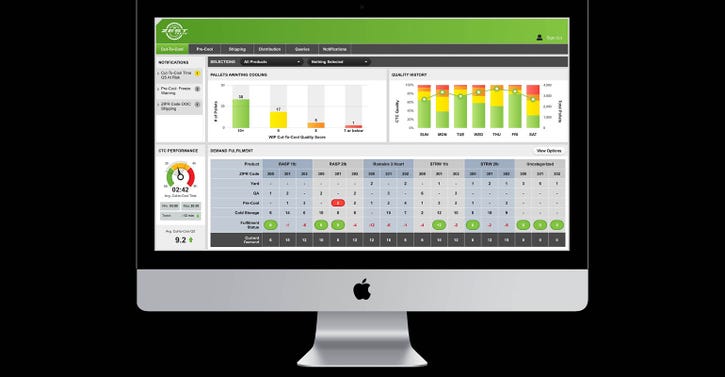Blockchain can be used in the waste and recycling industry to help ensure food safety within the fresh food supply chain; however, the solution needs reliable data to work.

Blockchain is a distributed digital ledger technology. Originally developed for cryptocurrencies, it is considered secure and immutable because data is stored on distributed servers and cannot be changed without the knowledge of others on the blockchain. Blockchain also has the capability to implement “smart contracts” that are automatically executed when specified conditions are met.
Blockchain can be used in the waste and recycling industry to help ensure food safety within the fresh food supply chain, providing traceability and potentially preventing mistakes in the handling or distribution of food. This is especially applicable to issues that result in recalls or foodborne illness outbreaks, according to Kevin Payne, vice president of marketing at Zest Labs based in San Jose, Calif.
“However, to do this successfully, the solution needs to have reliable data about a product’s condition and processing compliance as it moves through the supply chain,” he says. “When the right data and blockchain are coupled together, we have the potential to go beyond after-the-fact forensic analysis to proactive management of the cold chain, anticipating and reacting to issues before they become costly problems.”
Many industry experts have extolled the virtues of blockchain technology. Some paint it as a panacea to address every aspect of supply chain management.
“From our vantage point, we’ve integrated blockchain support into our Zest Fresh solution and have found that many suppliers are exploring blockchain and are asking us about it, but few, if any, are trialing or implementing it at this point,” says Payne. “The larger challenge isn’t so much with blockchain itself but with collecting the data to input into the blockchain. So much of the food industry is still paper based, and while efforts like the Produce Traceability Initiative have helped streamline data collection, data is often incomplete, unaudited and potentially inaccurate. So, if you put bad data into the blockchain, its value in terms of traceability and food safety is negligible.”

According to Kim Bui, FreshCloud global infrastructure and analytics director for AgroFresh based in Philadelphia, blockchain is an infant technology that is relatively unstable, expensive and complex to deploy at scale.
“Blockchain in fresh produce is currently limited to niche applications such as food safety and provenance,” he says. “Use cases for blockchain include elements of data integration for tracking produce from field to fork, ownership and quality. Blockchain distributed ledgers can address certain key pain points in fresh produce and spoilage, including inefficiency, process opacity and fraud.”
In the fresh produce industry, the most valuable improvements come from increasing freshness and safety. Growers and retailers need to reduce waste and spoilage and provide longer post-purchase shelf life.
“Few companies have had the appetite to lead development of a utility that would benefit the entire industry,” says Bui. “As a result, progress in developing blockchain has been slower than expected in the fresh produce industry. However, some industry consortiums have put blockchain under more scrutiny and adopted a more practical approach to development and funding.”
Payne says the most visible blockchain initiative is the IBM Food Trust, which consists of IBM and selected retailers and suppliers.
“I think the industry will be watching to see how it rolls out and how effective it is in 2019. We have seen some other tech companies running test projects with blockchain,” he says.

To achieve broad scale adoption, any new technology needs to provide value to all of its constituents, the suppliers as well as the retailers. When value is established across the supply chain, adoption will increase, according to Payne.
“Early in 2018, blockchain was the darling of all fresh food industry trends and many said it would solve the food safety and traceability problem,” he says. “But this early hype faded by the middle of the year amid various food safety outbreaks that went unresolved. … We expect that, in 2019, aside from Walmart’s initiative, there will continue to be trials and tests and maybe some smaller deployments later in the year.”
Bui agrees that adoption of blockchain technology in food supply will be slow.
“Given the lack of convincing at-scale use cases for blockchain and the fresh produce industry’s lack of a rallying cry, I believe 2019 will be a repeat of 2018,” he says. “At the end of the day, blockchain solutions need to show how they will revolutionize transaction processing and lead to material cost reductions and efficiency gains. The industry needs to show how benefits in terms of improved margin and waste reduction justify the changes required in market infrastructure and data governance.”
Related to food safety, suppliers, logistics companies and retailers need to utilize blockchain to make it effective for traceability and transparency. It’s important that data is collected from the time of harvest through to delivery to the retailer as there are potential impacts to freshness, quality and food safety all along the supply chain, says Payne.

“The integrity and value of the blockchain is only as good as the quality of the data it contains. In general, the fresh food industry, particularly for produce, is lacking in quality data about its products and processes,” he says. “We can and should improve automated data collection capabilities and do so at the pallet level where variation occurs. IoT [Internet of Things] sensors provide this capability. They can be applied to each pallet and autonomously collect data about the products’ condition and location, for example. That data can be analyzed to improve delivered freshness and traceability and provide valuable insights across the supply chain.”
Bui says the waste industry needs to modernize, and blockchain could be an element in its modernization efforts.
“Blockchain could be a tool to support the industry’s ambition to pursue digitalization, process simplification and collaboration. However, like the fresh produce industry, the waste and recycling industry needs further education,” he says. “Currently, there is a sense that blockchain is a poorly understood solution in search of a problem. Blockchain’s value to this industry comes from its network effects, which means that a majority of stakeholders must be aligned.”
About the Author(s)
You May Also Like


